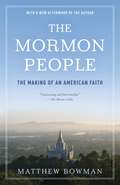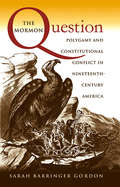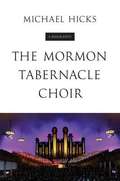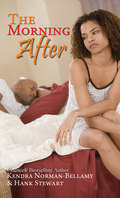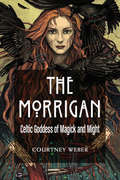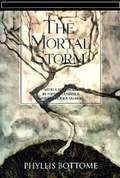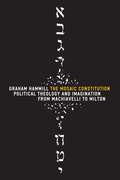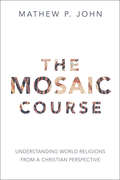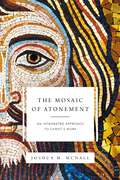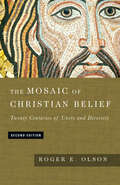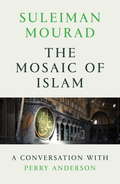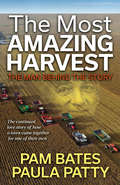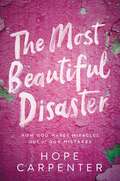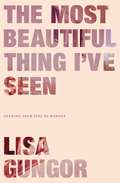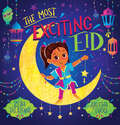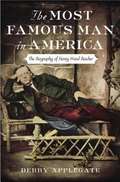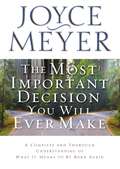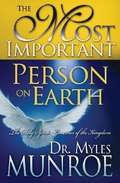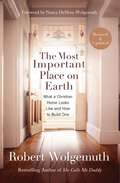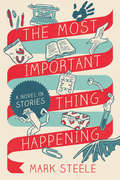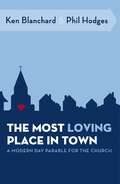- Table View
- List View
The Mormon People: The Making of an American Faith
by Matthew Bowman"From one of the brightest of the new generation of Mormon-studies scholars comes a crisp, engaging account of the religion's history."--The Wall Street Journal With Mormonism on the nation's radar as never before, religious historian Matthew Bowman has written an essential book that pulls back the curtain on more than 180 years of Mormon history and doctrine. He recounts the church's origins and explains how the Mormon vision has evolved--and with it the esteem in which Mormons have been held in the eyes of their countrymen. Admired on the one hand as hardworking paragons of family values, Mormons have also been derided as oddballs and persecuted as polygamists, heretics, and zealots. The place of Mormonism in public life continues to generate heated debate, yet the faith has never been more popular. One of the fastest-growing religions in the world, it retains an uneasy sense of its relationship with the main line of American culture. Mormons will surely play an even greater role in American civic life in the years ahead. The Mormon People comes as a vital addition to the corpus of American religious history--a frank and balanced demystification of a faith that remains a mystery for many.With a new afterword by the author. "Fascinating and fair-minded . . . a sweeping soup-to-nuts primer on Mormonism."--The Boston Globe "A cogent, judicious, and important account of a faith that has been an important element in American history but remained surprisingly misunderstood."--Michael Beschloss "A thorough, stimulating rendering of the Mormon past and present."--Kirkus Reviews "[A] smart, lucid history."--Tom Brokawis a church with a powerful sense of its own identity and an uneasy sense of its relationship with the main line of American culture. Mormons will surely play an even greater role in American civic life in the years ahead. In such a time, The Mormon People comes as a vital addition to the corpus of American religious history--a frank and fair-minded demystification of a faith that remains a mystery for many.
The Mormon Question
by Sarah Barringer GordonFrom the Mormon Church's public announcement of its sanction of polygamy in 1852 until its formal decision to abandon the practice in 1890, people on both sides of the "Mormon question" debated central questions of constitutional law. Did principles of religious freedom and local self-government protect Mormons' claim to a distinct, religiously based legal order? Or was polygamy, as its opponents claimed, a new form of slavery--this time for white women in Utah? And did constitutional principles dictate that democracy and true liberty were founded on separation of church and state? As Sarah Barringer Gordon shows, the answers to these questions finally yielded an apparent victory for antipolygamists in the late nineteenth century, but only after decades of argument, litigation, and open conflict. Victory came at a price; as attention and national resources poured into Utah in the late 1870s and 1880s, antipolygamists turned more and more to coercion and punishment in the name of freedom. They also left a legacy in constitutional law and political theory that still governs our treatment of religious life: Americans are free to believe, but they may well not be free to act on their beliefs.
The Mormon Tabernacle Choir: A Biography (Music in American Life)
by Michael HicksA first-of-its-kind history, The Mormon Tabernacle Choir tells the epic story of how an all-volunteer group founded by persecuted religious outcasts grew into a multimedia powerhouse synonymous with the mainstream and with Mormonism itself. Drawing on decades of work observing and researching the Mormon Tabernacle Choir, Michael Hicks examines the personalities, decisions, and controversies that shaped "America's choir." Here is the miraculous story behind the Tabernacle's world-famous acoustics, the anti-Mormonism that greeted early tours, the clashes with Church leaders over repertoire and presentation, the radio-driven boom in popularity, the competing visions of rival conductors, and the Choir's aspiration to be accepted within classical music even as Mormons sought acceptance within American culture at large. Everything from Billboard hits to TV appearances to White House performances paved the way for Mormonism's crossover triumph. Yet, as Hicks shows, such success raised fundamental concerns regarding the Choir's mission, functions, and image.
The Morning After
by Kendra Norman-Bellamy Hank StewartIt's been a year since the death of Ms. Essie Mae Richardson, the elderly pillar of the Braxton Parks community. Before her untimely demise, Essie's prayers brought redemption to many of her neighborhood's problems; but now the impact of her death and the unfinished business that it left behind is threatening to unravel all that she prayed so hard for God to mend. While Colin Stephens still enjoys a blissful marriage to his wife, Angel, unbeknownst to him, she is wrestling with the guilt and regret of never saying goodbye to the woman she loved like a mother. And while their guards are down, a voice from Ms. Essie's past steps in and threatens to steal the security that the Stephenses have taken for granted. To Jennifer's relief, her fifteen-year-old son, Jerrod, was saved from gang-related activities by Ms. Essie's love and guidance. But now, just when it seems that the teenager is on a winning track, he's blindsided by more trouble than the streets could have ever offered. Through prayers and patience, Elaine Demps gained her husband's forgiveness for her infidelities, but after more than a year, she can't understand why he still hasn't moved back into the bedroom with her. Love tells her to give him more time, but loneliness pushes her back to the mindset that sent her searching for love in all the wrong places. Ms. Essie taught them that everything happens according to God's perfect timing, but to those left behind, it seems that the timing of Ms. Essie's death was all too soon. How will they keep from falling apart without the glue that held them together?
The Morning Star
by Meir GottesmanAyelet Shtayner is tall, beautiful, talented - and single. When Deep Hollow Synagogue hits on a novel approach to the community's shidduch crisis, they unleash secrets that none could ever have imagined. Secrets that throw us back thousands of years to an ancient Jerusalem, where a dozen young boys are secluded in a Guarded Courtyard, waiting to play a vital role in the future of the Mikdash. <p><p> 2,000 Years Ago...Attackers thunder down on the crowding Levites, and the terrible battle is begun... Enemies from all corners of Judaea gather, intent on thwarting the young boys' scared mission. Success hinges on the rambunctious shoulders of Yehudah ben Yitzchak, a small figure straddled atop a huge bull, coal-black pei'ot flying. "You, yeled, you must keep on searching until you find her!" Even if that search continues until the rise of the morning star... <p> The Morning Star is studded with personalities we won't forget: Lemel the Shammas, who towers over Deep Hollow SYnagogue in the yeallow-and-orange jacket that is his second skin. Rabbi Shtayner, the beloved but little-understood rabbi of the community. Heshy Roiter, the bashful bus driver...People whose lives and pasts are intertwined in mysterious ways. In The Morning Star, Meir Uri Gottesman, bestselling author of Deep Blue and The Harp, gives us the gift of a story that is intriguing, uplifting, and breathtaking in its scope.
The Morrigan: Celtic Goddess of Magick and Might
by Courtney Weber&“A masterfully blend of history, mythology, spell work and personal anecdote that beautifully explores the depth and breadth of &‘The Great Queen.&’&” —Amy Blackthorn, priestess of The Morrigan, and author of Blackthorn&’s Botanical Magic&“She is the spirit of fury and peace, power and destruction, joy and terror,&” writes author Courtney Weber. "She is warrior, queen, death omen, mother, murderer, lover, spy, conspirator, faery, shape-shifter, healer, and sometimes the living earth itself. A captivating contradiction: a demonic female who both haunts and heals; benevolent in one moment, ghastly the next, and kind the moment after that.&”The Morrigan is one of Pagan Ireland&’s most famous—and notorious—goddesses. Her name translated as &“phantom queen&” or &“great queen,&” the Morrigan is famous for being a goddess of war, witchcraft and death, protection and retribution. This book also explores her patronage of motherhood, healing, shapeshifting, and the land. Classified among the Sidhe (fairies), the Morrigan dates back at least to Ireland&’s Iron Age, but she is as modern as she is ancient―enjoying a growing contemporary and global following.Author Courtney Weber provides a guide for the modern devotee of this complex, mysterious goddess that encompasses practical veneration with modern devotionals, entwined with traditional lore and Irish-Celtic history.
The Mortal Storm
by Phyllis BottomeFreya Roth has everything a young woman could want. Her father is a kind and brilliant professor, her mother loving and beautiful, and there are three fine brothers. She is studying to be a doctor, and her suitro is rich and handsome. Then Hitler comes into power. Her older half-brothers turn against their stepfather, who is Jewish, and both are members of the Nazi Party. At the same time, Freya meets a young Communist peasant with whom she falls in love. Personal and political differences destroy the family's once uncloded happiness, and danger grows for Freya. This book, written in 1938, foreshadowed the horrors of years to come. It was also a feminist statement, made in an entertaining way. A film of this story with James Steward and Margaret Sullivan radically changed the plot although some of the seeds that must have attracted the producers are still there. However, the book is much less conventional and more forthright. "The Mortal Storm" is a poignant, exciting and thought-provoking book.
The Mortality and Morality of Nations
by Uriel AbulofStanding at the edge of life's abyss, we seek meaningful order. We commonly find this 'symbolic immortality' in religion, civilization, state and nation. What happens, however, when the nation itself appears mortal? The Mortality and Morality of Nations seeks to answer this question, theoretically and empirically. It argues that mortality makes morality, and right makes might; the nation's sense of a looming abyss informs its quest for a higher moral ground, which, if reached, can bolster its vitality. The book investigates nationalism's promise of moral immortality and its limitations via three case studies: French Canadians, Israeli Jews, and Afrikaners. All three have been insecure about the validity of their identity or the viability of their polity, or both. They have sought partial redress in existential self-legitimation: by the nation, of the nation and for the nation's very existence.
The Mosaic Constitution: Political Theology and Imagination from Machiavelli to Milton
by Graham HammillIt is a common belief that scripture has no place in modern, secular politics. Graham Hammill challenges this notion in The Mosaic Constitution, arguing that Moses's constitution of Israel, which created people bound by the rule of law, was central to early modern writings about government and state. Hammill shows how political writers from Machiavelli to Spinoza drew on Mosaic narrative to imagine constitutional forms of government. At the same time, literary writers like Christopher Marlowe, Michael Drayton, and John Milton turned to Hebrew scripture to probe such fundamental divisions as those between populace and multitude, citizenship and race, and obedience and individual choice. As these writers used biblical narrative to fuse politics with the creative resources of language, Mosaic narrative also gave them a means for exploring divine authority as a product of literary imagination. The first book to place Hebrew scripture at the cutting edge of seventeenth-century literary and political innovation, The Mosaic Constitution offers a fresh perspective on political theology and the relations between literary representation and the founding of political communities.
The Mosaic Course: Understanding World Religions from a Christian Perspective
by Mathew P. JohnHow do we affirm the biblical notion that Jesus is the only way to God while respecting people of other religious traditions and worldviews? The Mosaic Course: Understanding World Religions from a Christian Perspective answers this complex question by taking readers on an exciting journey exploring hidden revelations of Jesus Christ in world religions. Used in conjunction with the Mosaic Video Series available at themosaiccourse.org, Christians are equipped to engage in open and respectful dialogue with people of differing worldviews. Without compromising the fundamental faith conviction that Jesus is the only way to God, this study guide empowers readers to share their faith with people of other religious traditions in a culturally sensitive fashion.
The Mosaic of Atonement: An Integrated Approach to Christ's Work
by Joshua M. McNallThe Mosaic of Atonement offers a fresh and integrated approach to historic models of atonement.While modern treatments of the doctrine have tended toward either a defensive hierarchy, in which one model is singled out as most important, or a disconnected plurality, in which multiple images are affirmed but with no order of arrangement, this book argues for a reintegration of four famous "pieces" of atonement doctrine through the governing image of Christ-shaped mosaic.Unlike a photograph in which tiny pixels present a seamless blending of color and shape, a mosaic allows each piece to retain its recognizable particularity, while also integrating them in the service of a single larger image. If one stands close, one can identify individual squares of glass or tile that compose the greater picture. And if one steps back, there is the larger picture to be admired. Yet in the great mosaics of age-old Christian churches, the goal is not for viewers to construct the image, as in a puzzle, but to appreciate it.So too with this mosaic of atonement doctrine. While no one model is set above or against the others, the book notes particular ways in which the "pieces"--the feet, heart, head, and hands--mutually support one another to form a more holistic vision of Christ's work. "This is my body," Jesus said to his followers, and by reintegrating these oft-dismembered aspects of atonement, we will note fresh ways in which it was given for us.
The Mosaic of Christian Belief: Twenty Centuries of Unity and Diversity
by Roger E. OlsonIn The Mosaic of Christian Belief Roger E. Olson thematically traces the contours of Christian belief down through the ages, revealing a pattern of both unity and diversity. He finds a consensus of teaching that is both unitive and able to incorporate a faithful diversity when not forced into the molds of false either-or alternatives. The mosaic that emerges from Olson's work, now updated throughout and with a new chapter on the Holy Spirit, displays a mediating evangelical theology that is irenic in spirit and tone. Olson, writing with nonspecialists in mind, has masterfully sketched out the contours of the Great Tradition of the Christian faith with simplicity while avoiding oversimplification.
The Mosaic of Islam: A Conversation with Perry Anderson
by Perry Anderson Suleiman MouradA comprehensive introduction to the faith and politics of IslamToday, 23 percent of the global population is Muslim, but ignorance and misinformation about Islam persist. In this fascinating and useful book, Perry Anderson interviews the noted scholar of Islam Suleiman Mourad about the Qurʾan and the history of the faith.Mourad elucidates the different stages in Islam's development: the Qurʾan as scripture and the history of its codification; Muhammad and the significance of his Sunna and Hadith; the Sunni-Shiʿi split and the formation of various sects; the development of jihad; the transition to modernity and the challenges of reform; and the complexities of Islam in the modern world. He also looks at Wahhabism from its inception in the eighteenth century to its present-day position as the movement that galvanized modern Salafism and gave rise to militant Islam or jihadism.The Mosaic of Islam reveals both the richness and the fissures of the faith. It speaks of the different voices claiming to represent the religion and spans peaceful groups and manifestations as well as the bloody confrontations that disfigure the Middle East, such as the Saudi intervention in the Yemen and the collapse of Syria and Iraq.From the Trade Paperback edition.
The Most Amazing Harvest: The Man Behind the Story
by Pam Bates Paula PattyThe heartwarming true story of a farmer’s unwavering faith in the face of a tragic prognosis—and how a community came together to help a neighbor in need.In the summer of 2015, Carl Bates and his wife Pam received the devastating news that he had metastatic cancer. The doctors have him just three months to live. As farmers in Galva, Illinois, they were dealing not only with the profound grief of Carl’s illness, but a serious practical concern: who would harvest the crops?Despite the crisis he faced, Carl never lost his faith in God. When word of his situation got out, a group of fellow farmers gathered organized to harvest Carl’s crops themselves. Someone observed that “a farmer can ask for no better crop than a bountiful harvest of friends.”The event was covered by the news and became a viral phenomenon. Now, in The Most Amazing Harvest, Pam Bates and Paula Patty tell the full story of the remarkable farmer who kept his faith, and the small town community whose selfless act of kindness was nothing short of a miracle.
The Most Beautiful Disaster: How God Makes Miracles Out of Our Mistakes
by Hope CarpenterHope Carpenter nearly destroyed her family, her church, and her ministry by living a double life, but then God did something miraculous. Out of her brokenness, He made something beautiful.As co-pastor of one of the nation's largest megachurches, Hope Carpenter had perfected the roles of supportive wife, good mother, devoted worship leader, and dutiful homemaker. But inside, she was secretly ashamed, sad, and afraid. She didn't know who she was, and she didn't know how to ask for help without bringing down the whole façade. A series of bad choices led to multiple affairs; her husband kicked her out and announced from the pulpit of their church that their marriage was over.Hope was sure her life was done. But in her lowest moments, something beautiful happened. God met her there, and, with a lot of hard work, time, and mountains of therapy, she started to understand the pain that had caused her to act out. She and her family faced their brokenness together, and in powerful acts of forgiveness only God could have arranged, they all found real breakthrough and healing. Ron and Hope rebuilt their marriage and their family, and their ministry thrives today.In The Most Beautiful Disaster, Hope helps readers understand the lasting impact of childhood trauma and gives readers practical steps to uncovering the root of pain in their own lives. She shows how small decisions can lead to big changes, and helps readers find healing and wholeness in Scripture and prayer. Ultimately, readers will be led to hope, reconciliation, and true freedom.
The Most Beautiful Thing I’ve Seen: Opening Your Eyes to Wonder
by Lisa GungorLisa Gungor thought she knew her own story: small-town girl meets boy in college and they blissfully walk down the aisle into happily ever after. Their Christian faith was their lens and foundation for everything—their marriage, their music, their dreams for the future. But as their dreams began to come true, she began to wonder if her religion was really representative of the ‘good news’ she had been taught.She never expected the questions to lead as far as they did when her husband told her he no longer believed in God. The death of a friend, the unraveling of relationships and career, the loss of a worldview, and the birth of a baby girl with two heart defects all led Lisa to a tumultuous place; one of depression and despair. And it was there that her perspective on everything changed. The Most Beautiful Thing I’ve Seen tells the story of what can happen when you dare to let go of what you think to be true; to shift the kaleidoscope and see new colors and dimension by way of broken pieces.Lisa’s eloquent, soul-stirring memoir brings you to a music stage before thousands of fans and a front porch where two people whisper words that scare them to the core. It is the story of how doubt can spark the beginning of deeper faith; how a baby born with a broken heart can bring love and healing to the hearts of many, and ultimately, how the hardest experience in life often ends up saving us.
The Most Exciting Eid
by Zeba TalkhaniJoin Safa and her family for Eid al-Fitr in this heartwarming celebration of the holiday!Eid al-Fitr is nearly here! Follow along with Safa and her loved ones during their vibrant celebration of Eid, the Islamic holiday marking the end of Ramadan.Safa can't wait to participate in all of her favorite holiday traditions: decorating the house, eating yummy food, henna, and enjoying the big family gathering! Safa loves sharing special moments and gifts with her family. But she's also having a hard time sharing her Eid gifts with her cousin, Alissa. Will Safa learn what the spirit of Eid al-Fitr is truly all about?With beautiful illustrations, joyous text, and an important lesson about the gift of giving, this book is perfect for holiday celebrations and family sharing!
The Most Famous Man in America: The Biography of Henry Ward Beecher
by Debby ApplegateNo one predicted success for Henry Ward Beecher at his birth in 1813. The blithe, boisterous son of the last great Puritan minister, he seemed destined to be overshadowed by his brilliant siblings—especially his sister, Harriet Beecher Stowe, who penned the century’s bestselling book Uncle Tom’s Cabin. But when pushed into the ministry, the charismatic Beecher found international fame by shedding his father Lyman's Old Testament–style fire-and-brimstone theology and instead preaching a New Testament–based gospel of unconditional love and healing, becoming one of the founding fathers of modern American Christianity. By the 1850s, his spectacular sermons at Plymouth Church in Brooklyn Heights had made him New York’s number one tourist attraction, so wildly popular that the ferries from Manhattan to Brooklyn were dubbed “Beecher Boats.” <P><P> Beecher inserted himself into nearly every important drama of the era—among them the antislavery and women’s suffrage movements, the rise of the entertainment industry and tabloid press, and controversies ranging from Darwinian evolution to presidential politics. He was notorious for his irreverent humor and melodramatic gestures, such as auctioning slaves to freedom in his pulpit and shipping rifles—nicknamed “Beecher’s Bibles”—to the antislavery resistance fighters in Kansas. Thinkers such as Emerson, Thoreau, Whitman, and Twain befriended—and sometimes parodied—him.<P> And then it all fell apart. In 1872 Beecher was accused by feminist firebrand Victoria Woodhull of adultery with one of his most pious parishioners. Suddenly the “Gospel of Love” seemed to rationalize a life of lust. The cuckolded husband brought charges of “criminal conversation” in a salacious trial that became the most widely covered event of the century, garnering more newspaper headlines than the entire Civil War. Beecher survived, but his reputation and his causes—from women’s rights to progressive evangelicalism—suffered devastating setbacks that echo to this day.<P> Featuring the page-turning suspense of a novel and dramatic new historical evidence, Debby Applegate has written the definitive biography of this captivating, mercurial, and sometimes infuriating figure. In our own time, when religion and politics are again colliding and adultery in high places still commands headlines, Beecher’s story sheds new light on the culture and conflicts of contemporary America.<P> Pulitzer Prize Winner
The Most Important Decision You Will Ever Make: A Complete and Thorough Understanding of What It Means to Be Born Again
by Joyce MeyerThis book outlines God's plan for salvation so you can make an informed decision about your beliefs and future.
The Most Important Person on Earth: The Holy Spirit, Governor of the Kingdom
by Myles MunroeIn The Most Important Person on Earth, best-selling author Dr. Myles Munroe explains how the Holy Spirit is the Governor of God's kingdom on earth, much as royal governors administered the will of earthly kings in their territories. When we struggle with defeat and discouragement, the Holy Spirit is the key to victory and peace. Learn how to; Bring order to the chaos in your life, Receive God's power to heal and deliver, Fulfill your true purpose with joy,Be a Leader in your Sphere of Influence, Be part of God's government on earth. Under the guidance and enabling of the Holy Spirit, we are the kingdom's representatives-bringing hope, healing, joy, peace, and power in the name of the King. Enter into his purpose and power for your life today.
The Most Important Place on Earth: What a Christian Home Looks Like and How to Build One
by Robert WolgemuthIt all starts at home. Newly revised and updated, The Most Important Place on Earth is Robert Wolgemuth's inspiring and practical book for those looking for a strong foundation for their home. So what's so great about a Christian home? There you will find redemption, forgiveness, hope, laughter, and genuine happiness. There you will also find discipline, purpose, and grace. Lots of grace. Many people did not grow up in a Christian home, and many more do not consider their childhood experience a good model. The Most Important Place on Earth covers eight answers to the question, "What does a Christian home look like?" It is filled with stories and useful ideas that will convince any reader that a Christian home is not an elusive stereotype. It is something that really can be achieved. And it is something worth having. You'll see.
The Most Important Thing Happening
by Mark SteeleFantastical Stories of Timeless TruthsA boardwalk peddler selling one ounce of God. A gentle mute who unwittingly triggers a tragic chain of events. Two businessmen declaring war over the Very Last Sandwich in the Entire World. The characters in the eleven short stories of The Most Important Thing Happening move through the whimsical, the mysterious, and the introspective toward the hope your soul longs for. So allow these stories to unfold before you one at a time. Chew on them. Let them haunt you. Go ahead and make a few fictional friends. Take a look at the world in a new way. You may come out the other side transformed.
The Most Loving Place in Town: A Modern Day Parable for the Church
by Ken BlanchardA moving story, told in Ken Blanchard's appealing parable style, of how a local church can be either a blessing or a curse to their community. The Most Loving Place in Town is the story of two men, a disillusioned church elder and a gifted young pastor, who recognize that their church has lost sight of its number one priority: loving God and each other. They begin a search, independently at first, to recapture their lost love and then together lead their fellowship in a successful discovery of the secret to becoming a beacon of love in their community. By the end of the story you clearly see and understand why this secret, so simple yet so profound, is vital and how to apply it to your own life and the life of your church.
The Most Misunderstood Women of the Bible: What Their Stories Teach Us About Thriving
by Mary E. DeMuthUnderstanding Isn&’t Overrated. Ask any woman—most of us know what it&’s like to be misheard, mischaracterized, or misrepresented by family, friends, or strangers. Few of us feel deeply known and understood all the time. Worse, many of us have endured long, painful seasons of misunderstanding in which the people around us have questioned—or worse, judged—our motives and actions. We have asked ourselves, How do I correct these misperceptions? Do I try to defend myself—or does that only make me look guilty? How can I recover my joy even if someone believes something about me that isn&’t true? This problem—and your feelings and questions about it—is nothing new. In fact, women have faced it since the dawn of time. In this engaging book, Mary DeMuth tells the tales of ten women in the Bible who were misunderstood in their own time and often still are—bringing to each of them a deep humanity that makes her, and her problems, more relatable to twenty-first-century you. If you are struggling with feeling misunderstood, let these stories inspire you to grow and remind you that you are not alone. And remember: There is always One who understands you perfectly and stands ready to comfort, strengthen, and defend you through every situation you face.
The Most Noble of People: Religious, Ethnic, and Gender Identity in Muslim Spain
by Jessica CoopeThe Most Noble of People presents a nuanced look at questions of identity in Muslim Spain under the Umayyads, an Arab dynasty that ruled from 756 to 1031. With a social historical emphasis on relations among different religious and ethnic groups, and between men and women, Jessica A. Coope considers the ways in which personal and cultural identity in al-Andalus could be alternately fluid and contentious. The opening chapters define Arab and Muslim identity as those categories were understood in Muslim Spain, highlighting the unique aspects of this society as well as its similarities with other parts of the medieval Islamic world. The book goes on to discuss what it meant to be a Jew or Christian in Spain under Islamic rule, and the degree to which non-Muslims were full participants in society. Following this is a consideration of gender identity as defined by Islamic law and by less normative sources like literature and mystical texts. It concludes by focusing on internal rebellions against the government of Muslim Spain, particularly the conflicts between Muslims who were ethnically Arab and those who were Berber or native Iberian, pointing to the limits of Muslim solidarity. Drawn from an unusually broad array of sources—including legal texts, religious polemic, chronicles, mystical texts, prose literature, and poetry, in both Arabic and Latin—many of Coope’s illustrations of life in al-Andalus also reflect something of the larger medieval world. Further, some key questions about gender, ethnicity, and religious identity that concerned people in Muslim Spain—for example, women’s status under Islamic law, or what it means to be a Muslim in different contexts and societies around the world—remain relevant today.
